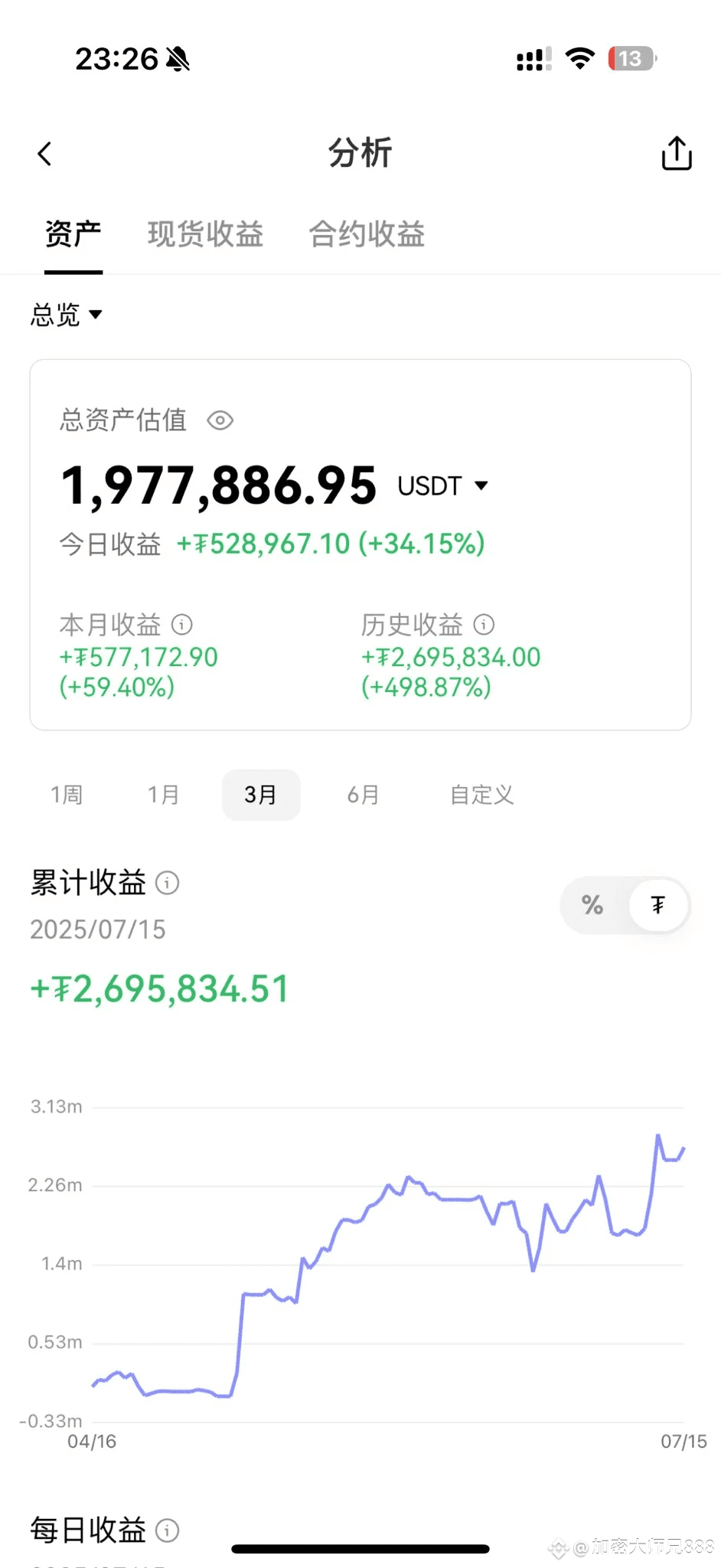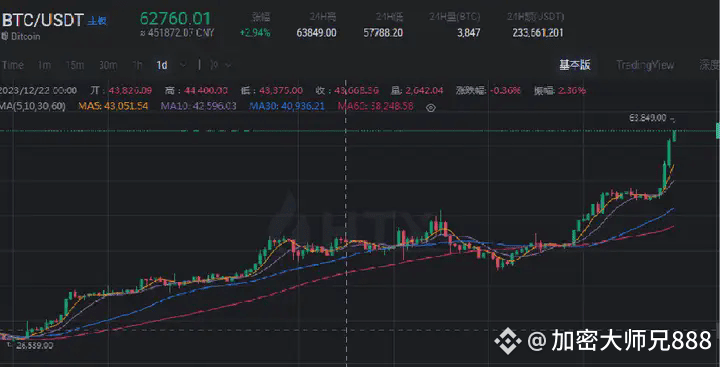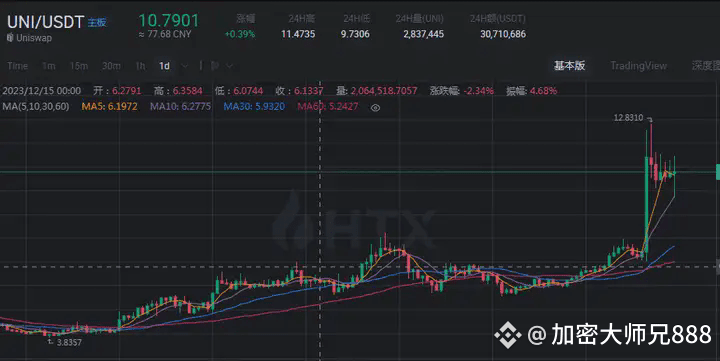His cryptocurrency trading method is different from traditional thinking; you don't need to know any candlesticks to profit over 50 times. He is my crypto mentor and benefactor, and I repeatedly share his methods with everyone because my trading system framework is built from the combination of my mentor's experience and my personality.
At the end of last year, I tried with 200,000, and now I have 20 million, effortlessly achieving a hundred times profit.
I am still using this method; it is suitable for everyone, with high and very stable returns.

Everyone need not worry about not being able to learn; if I can seize this opportunity, so can you. I am not a god, just an ordinary person, and the only difference between me and others is that others overlook this method. If you can learn it and pay attention in the subsequent trading process, it can help you earn at least an additional 3 to 10 points of profit daily.
Step 1: Select cryptocurrencies for your watchlist
Add cryptocurrencies that have increased in value over the last 11 days to your watchlist, but note that those that have declined for more than three consecutive days should be excluded to prevent capital from escaping with profits.
Step 2: Monthly level screening
Open the candlestick chart and only look at the cryptocurrencies that show a golden cross on the monthly MACD.
Step 3: Daily level screening and entry timing
Open the daily level candlestick chart and only look at a 60-day moving average. As long as the coin price pulls back near the 60 moving average and shows a volume spike candlestick afterward, enter the market heavily.
Step 4: Exit rules and details
After entering the market, use the 60 moving average as a standard; hold when the coin price is above the line and exit when it is below. Specifically, it can be divided into three details:
When the wave's increase exceeds 30%, sell one-third.
When the wave's increase exceeds 50%, sell another one-third.
This point is relatively important and is the key to whether you can profit: if you buy in on a day and the next day there is an unexpected situation where the coin price directly breaks below the 60-day moving average, you must exit completely without any luck.
Although the probability of the coin price breaking below the 60-day moving average is very small using this method of combining monthly and daily levels to select coins, we still need to have risk awareness. In the crypto world, preserving capital is very important. However, even if you have already sold, you can wait to buy back when it meets the buying criteria again.
Ultimately, if you want to make money, the difficulty is not in the method but in execution. You can choose not to believe in technology, not to believe in the market makers, not to believe in candlestick averages, not to believe in BTC, thinking they are all scams, and you can also choose to believe in them. These mindset issues will not hinder your ability to make money.
But there is only one thing you must understand: that is [risk]. What is risk, how to control risk, how to calculate risk, how to operate risk, how to withdraw from risk, how to survive.
You cannot earn money beyond your cognitive range. Originally, if you invest in a coin and its value doubles, you earn 100%; then if you do contracts at three times leverage, resulting in 300% profit, do you know where that extra money comes from?

In contract trading, the money earned is actually the money from risk management, which is the money given to you by others' losses and liquidations. To obtain this money, first, you must not be liquidated.
In fact, viewing the market from the perspective of [risk] is completely different from the ordinary person's view. It's like looking at a mountain from the bottom versus viewing it from the top; it is fundamentally different. Just to give an example, people who buy cryptocurrencies can hold positions and endure losses, emphasizing patience, but in contract trading, if you hold positions and wait while enduring losses, most likely you won't survive the first three episodes.
Therefore, operations truly based on [risk] management are completely different from those based on [dreams]. In the trading market, dreaming costs money, while those who manage [risk] strive to take that money into their hands.
So, do you want to be a [dreamer] or a [risk manager]? That depends on you. However, [dreamers] should not trade contracts; doing so will shatter the dreams built over years within a few days, and the awakening is too quick.

Anyone who has made a lot of money will have a feeling during the process of making money: 'That period of time was almost like picking up money casually, but when your opportunity comes, that is to say: when it's your turn to pick up money, you need to be alive and have the capital to pick up money.'
Yes, making money from contracts is not difficult. After all, there are so many people who give away money by getting liquidated. They are racing on the edge of a cliff; you just need to wait at the bottom of the cliff and pick up some parts to get by.
The difficulty lies in the fact that it is inherently counterintuitive; basically, you have to think against the ordinary people's mindset of 'getting rich overnight'. Whenever you are eager to increase your position or open a position, you need to consider: [what does it mean to go against human nature].
If buying cryptocurrencies is fishing, then trading contracts is boxing. So I say that there is a lot of time in cash positions; this is very normal. Waiting, testing, retreating, trying again, waiting again... this is the norm for successful speculators.
In fact, strategies for a period of time are almost straightforward and can be said to be known by everyone.
For example, on February 14, 2022, many teams' operational strategies are: shorting most cryptocurrencies while timing long positions on BTC for hedging.
The reason is not much to discuss; think of yourself as a big shot in the crypto world and deduce from there. With such an absolutely profitable strategy, 80% of people cannot make money trading contracts.
And this seemingly simple strategy actually contains countless details. For example, the simplest operational principles, why not short based on BTC directly, why shorting is much more conservative than going long, and the holding time is much shorter. When shorting, how to handle stop-loss, how to short various technical currencies... The stop-loss plan for contracts needs to be theoretical and worth studying; the value of stop-loss theory is at least half of what you invest in contracts. If you really cannot find it, you must derive a complete set of theories yourself, which means a complete set of operations, strictly executed, and there will always be opportunities.
Trading is like this: on the surface, it is extremely simple to buy and sell (one minute on stage), but behind it, countless people have done the groundwork (ten years of effort offstage). Overall, this is a profession. It is not that beginners cannot do it, but you must study and train seriously before you can truly step into the arena.

I often compare flying an airplane with speculating. The reason is that these two are quite similar; if you force yourself to fly without knowing how, the result is likely destruction and loss of life; if you force yourself to speculate without knowing how, you will inevitably get liquidated.
Risk management and stop-loss management are basically the fundamental skills of flying an airplane. With this, you can at least ensure that you won't die.
Furthermore, the methods for long and short positions in contracts are completely different. This is entirely different from forex, where it is the ratio of two currencies; here, it is the ratio of cryptocurrency to money, which are completely different things.
For example, I rarely see so many twists and turns in long and short positions; the reason for losses is that the way to trade short positions is actually different from long positions, and the way of thinking is also different. Short positions generally only take a slice, and they must be time-limited. But long positions are usually limited in quantity, and sometimes you can increase your position and consider holding. The entire approach is completely different. Therefore, actual speculation is a professional skill.